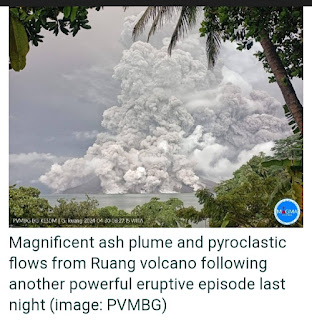Ruang Selective Activity Again
After more than twelve days since the last paroxysm episode, the volcano showed another very dramatic activity last night.
At about 01:15 local time, a vulcanian-type explosion occurred from the summit, generating a grey ash plume towards the north. This could be considered as a precursor of the massive eruption, happening (highly likely) at the time of this update.
At 02:35 local time, impressive incandescent lava fountains started to shoot into the sky. Continuous lava jets have been surpassing several hundreds of meters above the crater, towering pillars of glowing lava bombs and maybe even blocks have been landing onto the entire edifice and causing glowing avalanches. Some of pyroclastic material, visible in videos, falls outside the frame border, meaning that it reached considerable distances (greater than 2 km likely). Such high-magnitude explosive episode is known as paroxysm.
The lava-fountaining episode has been associated with a huge copious grey ash emissions, rising approx. 5 km above the edifice (at an altitude of 5,750 meters) in the eastern and southern direction. Given the height of the volcano (725 meters), the massive ash column covered nearly the entire edifice, obscuring it from view.
It also generated massive and dilute gravity-driven mass flows, known as pyroclastic flows, which poured down in all directions along the flanks towards the base perimeter, ultimately sinking into the sea.
The event has been accompanied by a magnificent volcanic lightning episode, often called “dirty thunderstorms.” These “dirty thunderstorms” are a dramatic form of static electricity release.
Lightning occurs when oppositely charged particles such as fragmented pieces of lava or ash grains collide with one another. Lightning happens more often closer to the vent. Like in regular thunderstorms, ice can enhance the electrification of larger eruptions that produce large-scale plume lightning. Ice can be present in colder climates or in clouds interacting with a volcanic plume. About the volcanic lightning phase, almost 16,000 instances of lightning have been detected within the eruption plume.
In order to mitigate the current risk, people are advised to avoid the area within approximately 6 km of the main crater.





Yorumlar
Yorum Gönder